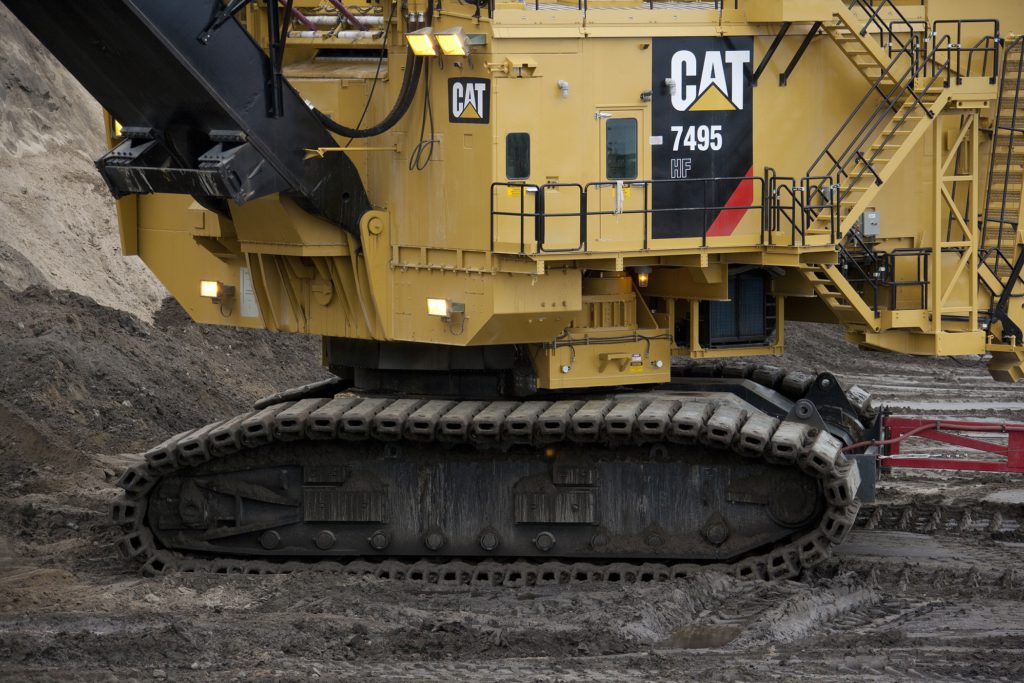
Caterpillar has added multiple design enhancements to its 7495 and 7495 HF electric rope shovel (ERS) models to the lower structures that increase machine reliability and significantly lower overall total cost of ownership. These upgrades cover the track (crawler) frames, swing rack and rollers, propel gearboxes and rotating undercarriage.
Combined, the design advancements can improve total cost of ownership up to 6% per operating hour and improve physical availability of the ERS up to 0.63%. All updates are found on current-year models and can be retrofitted independently in the field to allow existing customers to realize these substantial gains.
A reengineered bolt-on design for track link sliders eliminates the need for casting welds. Cat rope shovel customers can benefit from up to a 22% cost-per-hour reduction with extended wear life and no maintenance. Integral wear indicators provide visual reference to help service technicians plan for slider maintenance.
Track frame life is enhanced with increased frame thickness, lowering stress in the plate for improved reliability. A new super bolt arrangement features shorter middle bolts, improving joint stiffness and maintaining preload. Access for cleanout has been improved with a three-hole track frame bell housing.
Distributing shovel weight more evenly to the crawler side frame, the updated tapered shear ledge reduces end loading as the ERS pitches forward during digging. New lower side frame stiffeners maintain increased track clearance to the tracks, while improving rock protection.
Saving approximately 100 hours of field assembly time, the bolt-on motor base eliminates field welding and improves motor bolt access. Set screws simplify locating the base on the crawler and simplify motor alignment.
The swing rack absorbs the stress from every load. The 7495 and 7495 HF models now have a single-piece swing rack casting that eliminates previous vertical welds to improve ERS durability. The number of core holes have been reduced from 20 to four, positioned strategically in low-stress areas of the swing frame and located outboard to increase web strength. Improvements to the weld joint between the swing rack and car body further reduce stress.
An updated single-piece roller path increases roller life and eliminates seams to improve ride and prevent rollers from coming loose. Five symmetrical roller segments are now preassembled, improving alignment quality and installation efficiency. The upgraded thrust rail design improves access for inspection and retightening, while adding support to the thrust rail during operation.
The redesigned propel system eliminates the need to remove the propel transmission when servicing the drive tumbler and propel shaft, since they are now replaced from the outboard side of the machine. This significantly improves serviceability of the drive, decreases maintenance downtime by as much as 75% and lowers operating costs by as much as 10% versus the previous design. The component’s design updates extend rebuild life to up to 30,000 hours.
Sealed and continuously lubricated tapered roller bearings more evenly distribute thrust to improve propel durability. Fresh grease flows equally through both sets of bearings, eliminating potential contamination from bearing surfaces. Propel gearcase metallurgy has been optimized to improve toughness, while improved microgeometry enhances gear mesh to reduce contact wear.
Compatible with all ERS machines equipped with 2,006-mm track pads, a new track pad design improves structural support and steel chemistry. A proprietary heat treatment process increases hardness by 15% and toughness by 30% to improve roller path and drive lug wear.
The track pin design features improved alloy composition and higher toughness. A new track pin removal pocket for 7495 HF models offers an easy-to-use pin removal solution that features a weld-free integrated vertical surface to keep the cylinder stabilized during pin removal.